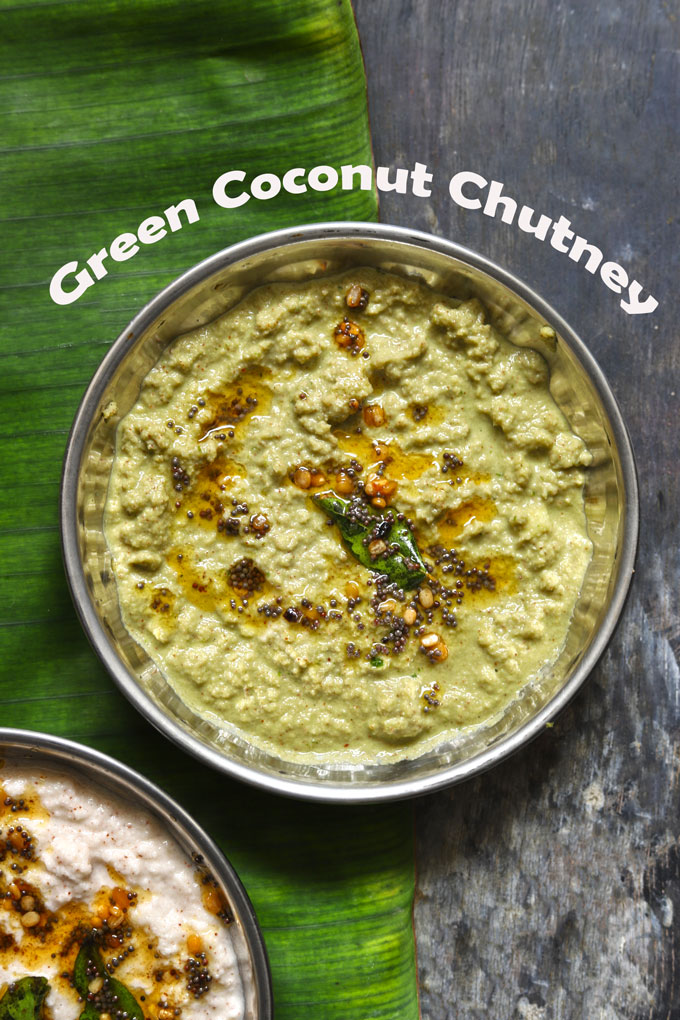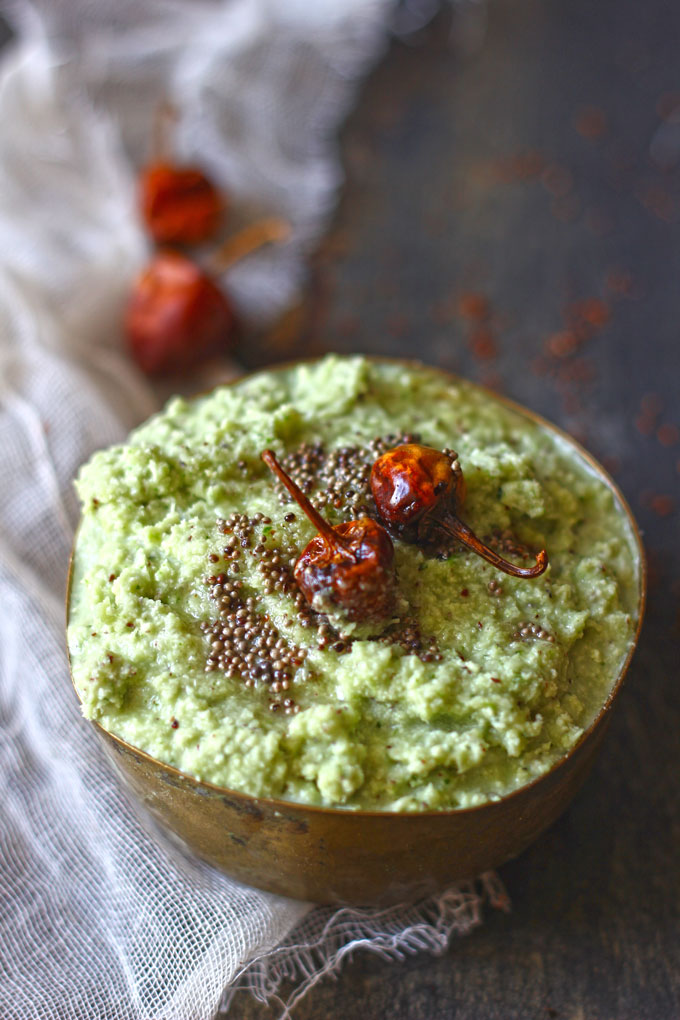Coconut chutney is a traditional South Indian side dish packed with the flavour of coconut. It is a fabulous gluten-free and vegan-friendly Indian chutney recipe.

In South Indian Cuisine, the coconut is abundantly used. The reason is the tall, handsome coconut trees standing by the sea coast with utmost pride.
From curries, chutney to poriyal, and desserts, the coconut is omnipresent in the local South Indian and Coastal dishes.
Coconut Chutney is one of the most popular South Indian side dishes. It tastes fabulous with the deep-fried snacks and the South Indian breakfast such as idli, vada, dosa, etc.

My Green Coconut Chutney
I love the splash of green colour and freshness in my chutney. Hence, I add fresh coriander leaves along with coconut, salt, green chilli, and water while blending. The addition of fresh coriander leaves and green chilli makes this chutney unique.
Unlike North Indian-style coriander chutney, this green chutney is tempered.
The fresh coriander leaves give the chutney a bright green colour, making it taste refreshing and rich in anti-oxidant.

Coconut Chutney Recipe Variations
There are many variations of nariyal chutney followed across South India.
- Traditional Chutney: Blend coconut, green chilli, salt, and water to a smooth paste. Later, temper with whole red chillies, mustard seeds, urad dal, and curry leaves fried in ghee. This is the simplest and the easiest South Indian chutney recipe.
- Red Chutney: Fry onion and tomato in ghee. Blend with the remaining ingredients for the chutney.
- Peanut Chutney: Replace half the coconut with skinned, roasted peanuts for a nutty taste.
- Garlic Chutney: Add garlic cloves according to taste preference while blending the ingredients to give the chutney a garlicky flavour.
The Tadka (Tempering)
The tadka of a South Indian chutney is mainly – ghee, black mustard seeds (rai), white urad dal, curry leaves, and dry red chillies.
The simple but aromatic tempering complements the mild flavour of the chutney and adds a crunchy layer on top.
To make a vegan chutney, you can use coconut, groundnut, or any other vegan oil to fry the tempering ingredients.

How do you store coconut chutney?
Transfer the chutney to a container with a tight-fitting lid and store it in the refrigerator. It remains fresh for 4 – 5 days easily. For freezing the chutney, use a freezer-friendly container or zip lock bag for storing it. You can freeze it for 1 – 2 months. Avoid leaving chutney at room temperature for too long, especially during summer.
Can I use frozen or packaged desiccated coconut?
You can use frozen or packaged desiccated coconut for making the chutney. Defrost the frozen coconut as per packet instructions before making the chutney.
Serving Suggestion
I LOVE coconut chutney with everything and anything. But a few of my favourite combinations are:

Subscribe to our weekly newsletter or follow us on Youtube for video recipes.
If you try this recipe and love it, please leave a comment and a rating. This helps us grow and reach other food lovers like you.

Coconut Chutney Recipe
- Blender
- Stir Fry Pan
Ingredients
- 1 Cup fresh grated coconut
- 1 Cup fresh coriander leaves
- 1 – 2 green chilies or to taste
- Salt to taste
Ingredients For Tempering:
- 1 tablespoon ghee or coconut oil
- 1 – 2 dry red chili, broken into halves
- 2 tablespoon curry leaves
- 1 teaspoon mustard seeds (rai)
Instructions
- To prepare the Coconut Coriander Chutney, chop the coconut scrapping into bite-size pieces, or grate the coconut. You can use the readymade desiccated coconut as well.
- Add coconut, coriander, green chili, and salt in a blender and grind till smooth. Add approximately ¼ cup of water to get the smooth consistency of the chutney. Transfer chutney to a bowl.
- To temper the chutney, heat ghee or oil in a tadka pan over medium flame.
- Add mustard seeds. When the seeds crackle, add red chili and curry leaves.
- Once the curry leaves start changing color and the aroma of red chilies is released turn off the heat. Make sure not to heat the tempering for too long else curry leaves and chilies will turn bitter.
- Pour the tempering over the prepared coconut coriander chutney.
- Serve Coconut Coriander Chutney with dosa, idli or pongal.
Recipe Notes:
- If you do not have fresh coconut available, use dried desiccated coconut.
- For a vegan chutney, replace ghee with coconut oil or any other vegan oil.
- Many recipes suggest combining curd or roasted chana dal or peanuts in the coconut chutney. You can try these combinations as well.
- If the coconut chutney seems too thick, add more water while blending.
- You can store this chutney in the refrigerator for 1 week. Or freeze it for a month.





Swati ( The Tales of a Traveler ) says
Super easy and tasty .. thanks for sharing
http://thetalesofatraveler.com/2016/02/02/hotel-grand-dragon-ladakh-review/
Sheza says
Hi …
How long does this chutney keep ?
Can we freeze it ?
Thanks
Hina Gujral says
It remains fresh in the fridge for 3 – 4 days. I never tried freezing it. And I am sure the taste would not be the same after freezing. Thanks, Hina